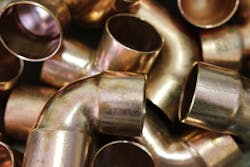Chloramines Found to Cause Leaks in Copper Pipe Systems
Your water might be safer, but your home is at risk of potential water damage caused by the possible failure of state-mandated copper piping, warns the California Professional Association of Specialty Contractors (CalPASC).
Research presented at CalPASC's recent Drinking Water Symposium points to copper pipe failure caused by the use of chloramines in California's water systems. Following federal guidelines from the Environment Protection Agency (EPA), the Metropolitan Water District, which supplies over 60% of the drinking water to cities in California, has switched to the use of chloramines to keep drinking water bacteria free.
Chloramines are compounds containing a mixture of chlorine and ammonia that extend the disinfecting power of chlorine in drinking water.
However, this chloramine treatment also may cause pinhole leaks in the copper tubing carrying the water. This same tubing is what California law stipulates plumbers must use as industrial and residential water pipe.
To date, there are over 5,000 pin-hole leaks reported in copper after switching to chloramines.
"California is the only state in the U.S. that promotes copper piping by restricting the use of plastic piping alternatives," said Tom Price of CDR Concrete, a former plumbing contractor himself. "With the safer water treatments, we're seeing not only more leaks nationwide, but potentially dangerous health effects."
Price is referring to recent studies in Washington, D.C., that showed dramatically increased levels of lead in the drinking water as well as detectable copper levels in some tested California water.
Noted research scientist Dr. Larry Sparks of Sun Health Research Institute told the symposium about findings showing a direct link between copper and early Alzheimer's disease. The same anti-bacterial chloramines may be producing what the EPA calls "aggressive" water with an ability to leach out the minerals, metals or other materials of whatever it touches or passes over.
"CalPASC wants the public to know what they're really drinking," said Beth Curran, executive director of CalPASC's Orange County, Inland Empire chapter. "If water treatment is pulling the lead out of old pipes and the copper and aluminum out of newer metal piping, and these elements are showing up in our drinking water, shouldn't California join the rest of the country and switch to non-metallic piping?"
While plastic piping, such as CPVC and PEX, is approved in the Uniform Plumbing Code, the state currently imposes cumbersome restrictions on its use.
CalPASC not only recommends California change to plastic piping, which its members believe increases water safety and reliability, but also estimates plastic piping products would save Californians $100 million annually in decreased labor and materials.
The costs associated with property damage, lower property value and increased insurance premiums from leaky copper pipes would also be avoided.
"Of course, we can't calculate the potential savings in health care expenses," adds Curran. "But the research is clear. Safer water must be piped in a safer manner."
The California Professional Association of Specialty Contractors (CalPASC) is represented and managed by its members. CalPASC exists to advance and protect the welfare of specialty trade contractors, suppliers and related businesses and to represent the position of the trade contractor industry in the California legislative, political, judicial and regulatory arenas.
Source: CalPASC
